
The night of Friday, May 10th 2024 will not be forgotten by those who witnessed the incredible Aurora show, bright, clear Northern Lights over the UK. For those who just went to bed and missed it, what bad luck. Sorry to repeat what you must have heard far too much but it was amazing!
Technically, what occurred was very interesting, from the Sun to both hemispheres on Earth. The strength of the event, an Extreme G5 (out of 5) geomagnetic storm. Why we witnessed the variety of colours and patterns, why some folk had to look overhead or even southwards this time and, as the sunspots swing back into view, if we do get another strong storm, how could you take even better photos of the Aurora?
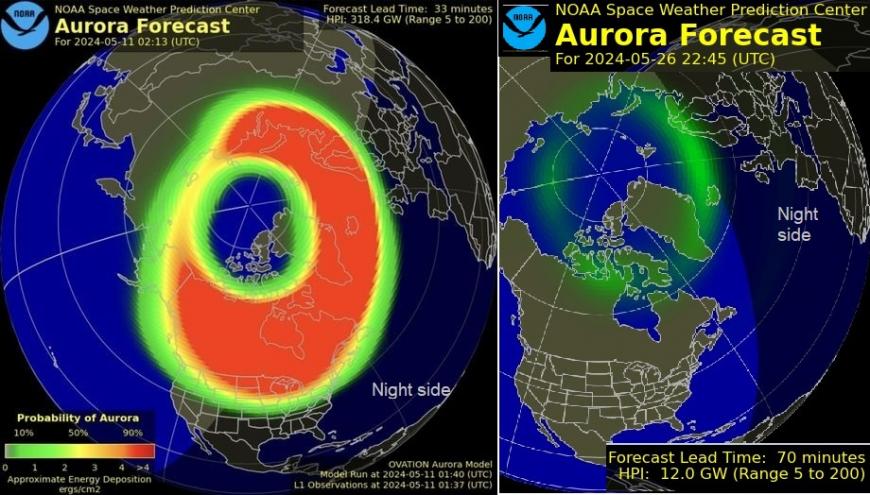 The auroral oval forecast from G5 storm night and a quieter one
The auroral oval forecast from G5 storm night and a quieter one
Waiting for the Northern Lights can be frustrating, a bit like fishing. Just another half an hour and something big might happen. An Aurora app can help but it is still a hit-and-miss game. There are many ingredients needed and even when those seem to line up, there can be nothing to see. It can be hugely frustrating or, as in early May, absolutely superb. Weather forecasting has improved greatly in recent decades and space weather is getting more attention now. Although it would be nice to have a guarantee of spotting a colourful aurora show, the reason for this focus are potentially serious impacts when one of these storms reaches the Earth. Hence more investment in Space Weather forecasting and spacecraft such as Vigil.
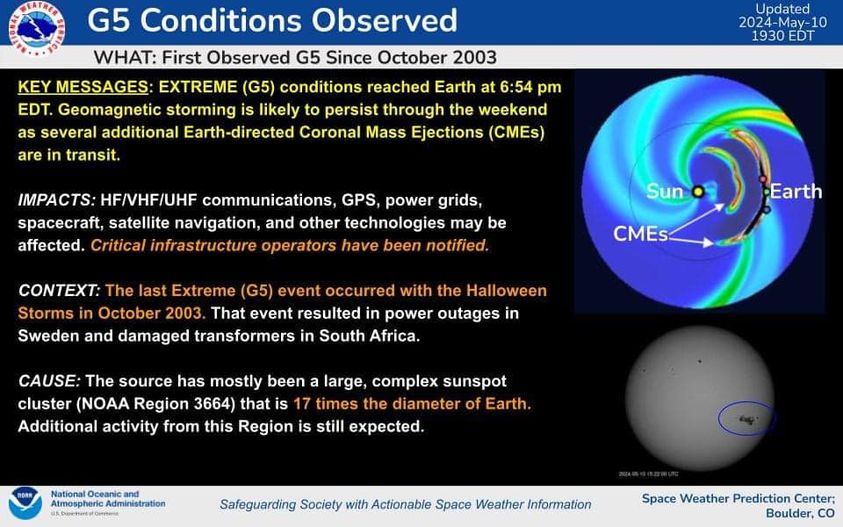
Our main problems in the UK are that we are usually too far south, away from the Arctic Circle or that pesky cloud ruins the view. You also need dark skies and we are now heading into the summer months. Solar activity runs in 11-year cycles and we are in a solar maximum with a peak of sunspot activity coming up. This means that storms and aurora events should occur more often.
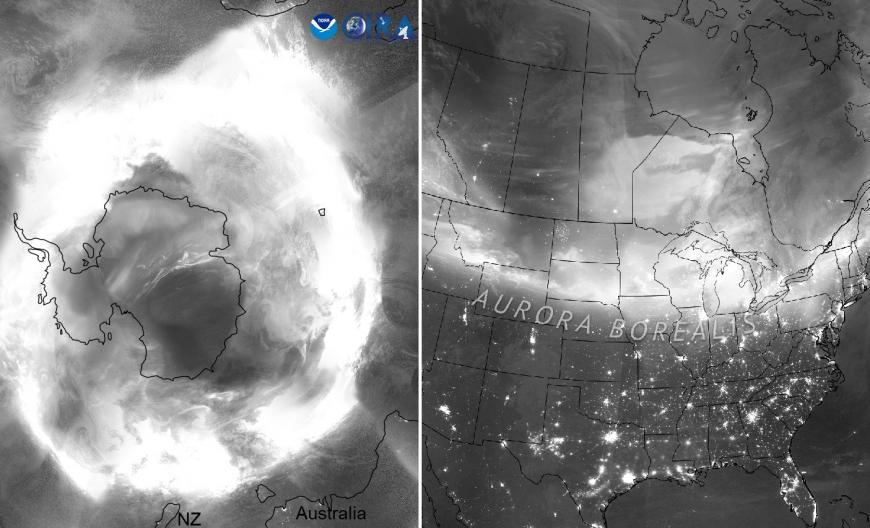 May 10th/11th Aurora Australis over the southern hemisphere and Aurora Borealis over North America
May 10th/11th Aurora Australis over the southern hemisphere and Aurora Borealis over North America
The auroral oval is a permanent feature above the Arctic and over the Antarctic. One side of the Earth will be facing the sun and the other, the night side, is where the Aurora might be seen. On the night side, the oval extends southwards which is why winter tourists visit places like Iceland, Lapland or Tromso. Netweather’s sister company run Weather Holidays Aurora tours. Being mobile is key as so often the green glow of the auroral oval is visible somewhere, but you need to be away from the cloud cover.
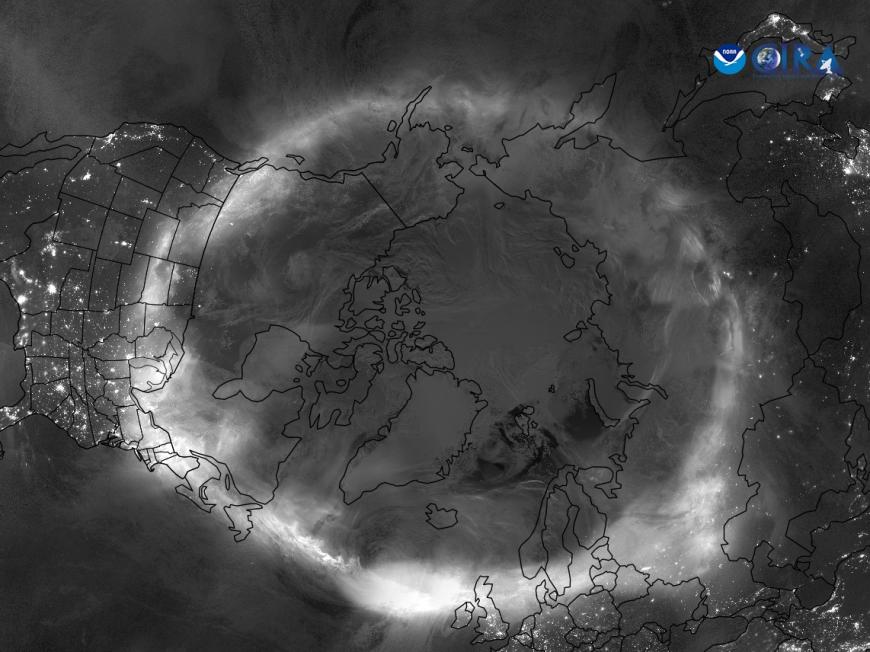 The astonishing range of the Northern Lights on May 10th
The astonishing range of the Northern Lights on May 10th
What onlookers are waiting for, once the discrete green arc appears in the distance, is enhanced activity, a turbo boost from the sun brought to the Earth’s magnetic field by the solar wind. This causes the oval widen and enlarge in diameter which means that it reaches further south. Perhaps to southern Scandinavia and the Northern Isles. There might be a secondary arc, it begins to wriggle and loop with a greenish show. With further energy from the sun, the aurora begins to dance or pulsate, the colours change and mystical shapes appear. The colours relate to the gases in our atmosphere: oxygen gives the green or red. Blue, violet and pink colours come from nitrogen molecules.
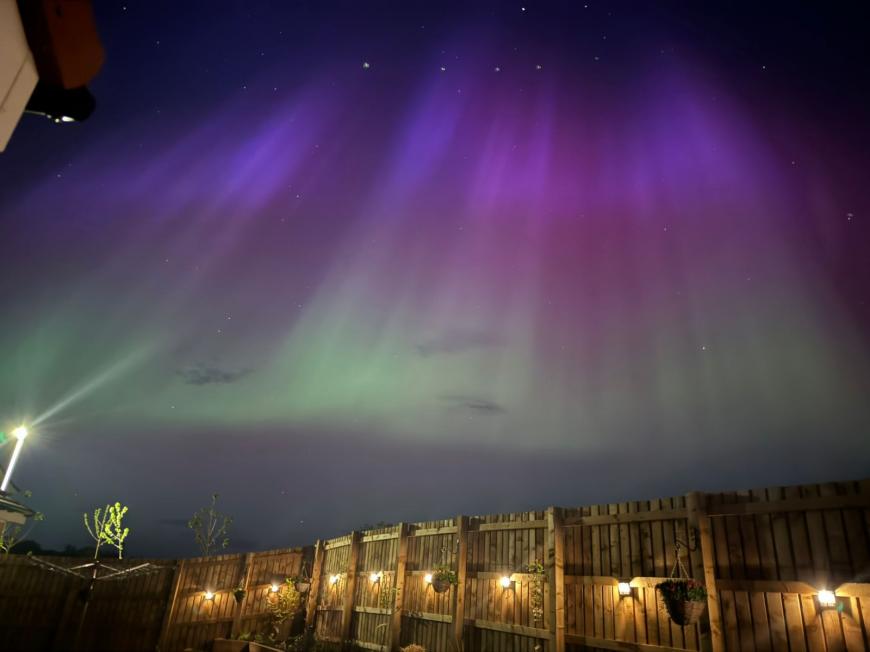 Southeast Scotland aurora, visible from towns. Image P. Dunn
Southeast Scotland aurora, visible from towns. Image P. Dunn
Usually, our views in the UK are away in the northern sky. The auroral oval has shifted south a bit and the green glow appears low on the horizon. Occasionally it is accompanied by a red glow above like curtains, even pillars and sometimes a violet colour. On the 10th, many people could just see it out of the window, from their garden or street.
There was such enhanced activity that the oval moved right across Scotland. This meant that those looking upwards over southern Scotland and northern England saw the Aurora right above their heads. And that is what you want, that is why people travel to the Arctic. Some people ended up looking the wrong way as they had to look south this time to spot the colours and movement. When this occurs there can be rays of light coming down from above, like pillars. For those who witnessed an almost starburst configuration, this was Coronae where multiple rays converge to a point. A bit like looking upwards in a forest and the treetops seem to come together in a zenith. Seeing that is a remarkable sight and very rare occurrence at such latitudes.
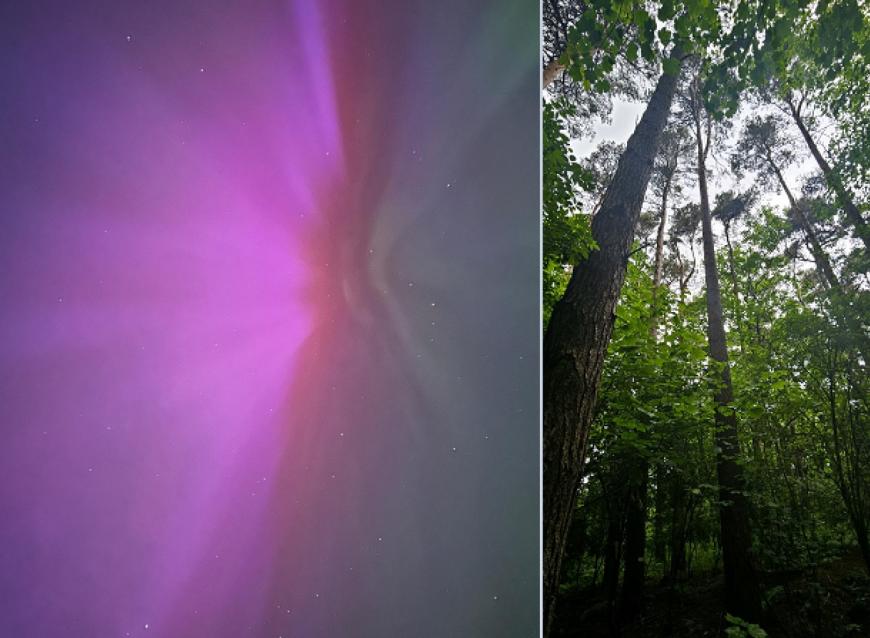 Aurora coronae SE Scotland Image M.Sangster
Aurora coronae SE Scotland Image M.Sangster
“Multiple Earth-directed CMEs (Coronal Mass Ejections) were observed leaving the Sun between Weds 8th and Thurs 9th May. Due to the relative speed of the various CMEs they are expected to combine into a single larger arrival towards the end of the day on Fri 10th or early Sat 11th May” Met Office
We had the key ingredients of clear skies over the UK and darkness (time of day) at the peak of the enhanced activity for the aurora. Then a G5 geomagnetic storm happened. The Sun has various sunspots and (AR) Active Regions which are numbered. Solar flares and eruptions occur causing CMEs, Coronal Mass Ejections.
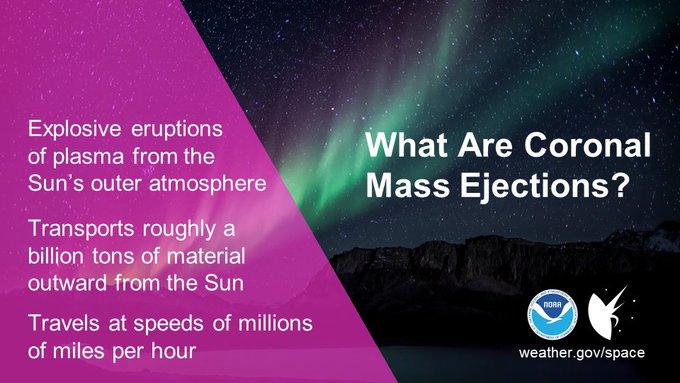
These might head off into space or they can be earth-directed. These are the ones of interest. In the week of Friday 10th several earth-directed CMEs left the Sun. Taking a few days, on the solar wind, to reach the Earth, some managed to catch up with each other and produced a powerful intense storm in our magnetosphere (the region dominated by the Earth’s magnetic field). At first, called a G4 Severe storm but as the huge amounts of energy became apparent it was upgraded to a G5 Extreme storm, the highest level which we have not experienced since 2003 and before that, 1989.
"The vast majority of NOAA Geomagnetic Scale 5 level storms (G5) will not cause catastrophic damage to the electric grid. On average, the Earth is impacted by such storms about four times during every 11-year solar cycle." NOAA
These storms and aurora can cause strong electric currents to be driven across the Earth’s surface. This can disrupt power supplies, degrade oil and gas pipelines and affect HF radio communications, GPS and aviation comms.
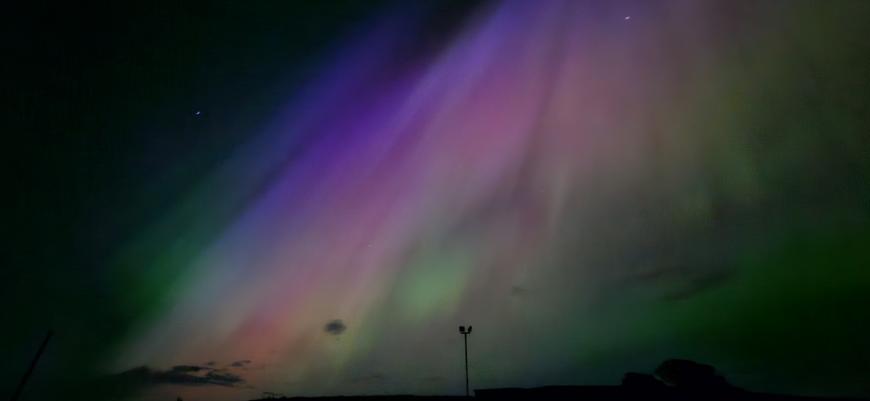
A large sunspot cluster complex AR3664 erupted with flares and released the CMEs that resulted in our G5 geomagnetic storm. The enhanced auroral activity only faded early on May 13th. As the sunspot cluster rotated to the other side of the Sun, away from the Earth it released a significant X8.79 flare on the 14th. On the 21st, the ESA's (European Space Agency) Solar Orbiter witnessed a huge flare on the back side of the Sun, the largest in 30 years. With another flare seen on May 27th X2.9, the same sunspot cluster has just come back into view, onto the visible solar disk. This is when earth-directed CMEs can occur. It now named AR3697 and solar flares have already caused short-lived radio blackouts Aurora watchers will be hopeful of more activity but the nights are shorter as we head into the summer months.
Photography
Different levels of photographs have appeared after the May 10th Aurora show. Fuzzy pale shots from those who didn’t know how to turn Night-Mode on their older iPhone. Others managed to change a few options in Android Pro settings, a longer exposure, higher ISO settings allowing the saturated colours to leap out, seeing so much more than our human eyes can manage. A tripod can help or just letting newer iPhones take charge. For those who have tried to photograph the aurora before, perhaps been on an Arctic trip or spent too much time on YouTube, there were better results. There are a few things that can give stunning pictures.
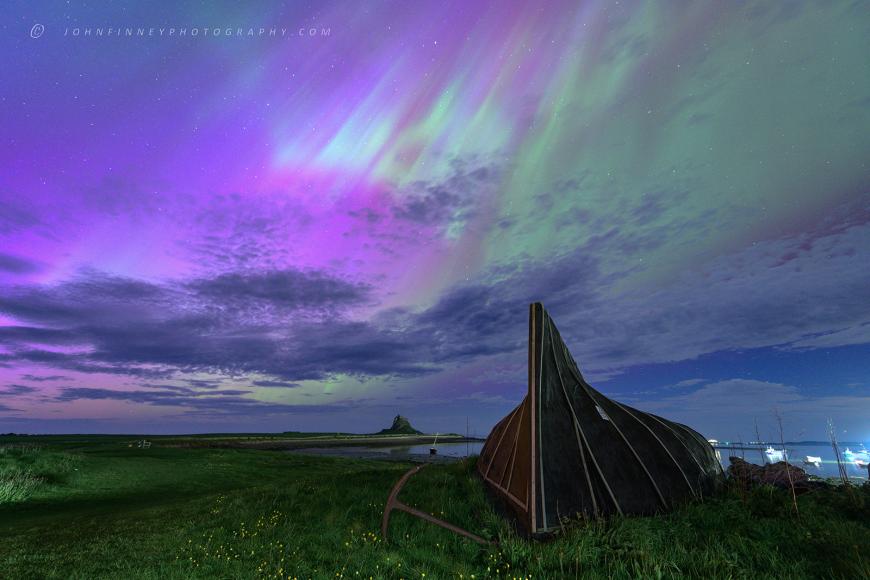
Photographer John Finney explained how he had obtained his dramatic photos at Lindisfarne off the coast of Northumberland.
“Capturing low-light scenes like the aurora requires a wide-angle lens with a wide aperture and a camera with a large sensor, mounted on a tripod, using a long shutter speed and a high ISO setting.
A wide aperture means your lens is more open, letting more light reach the sensor, and a larger sensor captures more light. ISO settings represent how sensitive your camera's sensor is to light. I use full-frame cameras with ultra-wide 14mm lenses with an f/2.8 aperture. I set a manual white balance and use manual focus, with a shutter speed between 10 and 20 seconds, and a sturdy tripod.” JF
Thoughtful composure can add a whole other dimension. Whilst most of us were just hugely excited and waving our phone cameras at the sky, clicking away unable to fit the whole spectacle in, the professionals were considering foreground and silhouettes. Trees, churches, a ruin or a body of water reflecting the incredible colours from the sky. Selective foreground lighting adds landscape, intrigue or just entertainment from a Northern Lights selfie. One huge bonus on May 10th was that it was so mild. People could stand outside for an hour or so gazing up at the sky and it wasn’t freezing cold. You don’t get that in the Arctic.
More solar discussion and Aurora chat in the Netweather forum Thanks to John Finney for the main aurora photographs
Loading recent activity...